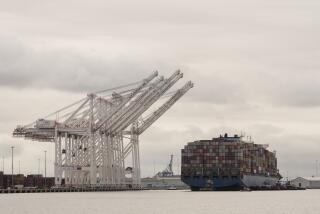St. Lawrence Seaway Is Reopening : Collapsed Wall Only One of Problems as Shipping Lags
- Share via
THOROLD, Canada — With the M. V. Furia, a hulking freighter of Liberian registry loaded down with more than 16,000 tons of American grain bound for Egypt, poised to nose into Lock 7 of the St. Lawrence Seaway’s Welland Canal, the only water link between the Great Lakes and the Atlantic Ocean was set to reopen for business early today.
Twenty-four days after a collapsed wall on Lock 7 forced the longest in-season shutdown in the seaway’s history, the lock has been repaired and refilled with water, and 130 ships trapped by the accident were expected to begin to make their way through the seaway’s reopened choke point in the dark between 4 and 5 this morning. Seaway officials had hoped to open the lock before midnight Wednesday, but they said last-minute repairs would delay the scheduled reopening by a few hours.
The canal, which cuts through the Canadian isthmus that separates lakes Erie and Ontario near Buffalo, N.Y., is the oldest part of the larger seaway system.
With 24 ships passing through each day, seaway officials predict that the huge and costly backlog of cargo ships--including many lined up in the deep-water lakes on either side of the canal--will be cleared out within a week. Great Lakes shippers, who have lost a total of about $1 million a day because of the accident, will then begin racing to make up for lost time to avoid getting caught once again, when the seaway begins to freeze over in December or January and closes for the winter.
But the St. Lawrence Seaway’s difficulties won’t end with its reopening. Today, both its critics and boosters agree that the seaway has failed to live up to the high hopes that its founders had in 1959 when it opened: the creation of a vital shipping lane along America’s “fourth coast.”
Even before the Welland accident on Oct. 14, cargo shipments were down 25% from year-ago levels as American and Canadian grain exports have sagged, and both the United States and Canada have been losing money on the jointly operated seaway this year. The United States, fearful of losing even more traffic, has been trying to stop Canada, which controls most of the seaway, from raising its tolls by 28% in 1986.
Even without toll increases, major businesses are shifting more and more of their freight away from the seaway to other forms of transportation. Many corporations with big operations in the industrial Midwest, the region most directly served by the seaway, say the shutdown was only a minor inconvenience, since they no longer rely on the seaway to move their products between the Midwest and the Atlantic.
“The damage to the seaway has not been a big concern for us, because we have so many alternative ports that we use now,” said Stephen Newhouse, a spokesman for Illinois-based Caterpillar Tractor.
“The seaway’s importance to us is declining,” added Lynn Phares, a spokeswoman for ConAgra, the Omaha-based agribusiness giant. “We were shifting away from using the seaway even before the accident, and the closing won’t have any impact on our total volume of grain shipments.”
In fact, few shipments of general cargo--manufactured goods or packaged products--go in or out of the seaway anymore, since the system’s locks are too small to accommodate today’s huge oceangoing container ships.
“I can remember back in the ‘60s, when we had 25 to 30 shipping lines carrying general cargo through the seaway to Detroit,” said Donald McCarty, executive vice president of the Detroit Marine Terminal. “Now, there is only one.”
The seaway’s limited season--it is usually open only 8 1/2 months a year--and shippers’ fears that the system is becoming less reliable also are hurting the seaway’s ability to attract more cargo.
“Nobody wants to build a small ship that can only operate 8 1/2 months a year,” said Vera Paktor, a spokeswoman for the Great Lakes Shipping Assn.
Worsened Credibility
This year’s accident has further worsened the seaway’s credibility, which was shaken just last year when the system was closed for 18 days because of a malfunctioning drawbridge.
Competitors--shippers able to carry freight by rail, river barge or truck between the Midwest and their ships docked at East and Gulf Coast ports--have capitalized on the seaway’s problems and now dominate Midwestern traffic for manufactured and packaged goods.
“Steamship lines that never bring a ship into the Great Lakes have marketing offices all over the Midwest,” to promote the use of rail transportation from the heartland directly to their ships at ocean and Gulf Coast ports, Paktor complained.
As a result, the seaway is seriously underutilized. With a capacity to handle 80 million tons of cargo annually, it carried just 47.5 million tons in 1984 and will handle even less this year. And it has been relegated to handling mostly low-value bulk cargoes, such as grain, iron ore, scrap metal and imported steel.
Even in those bulk products, the seaway is less important to the United States than it is to Canada.
While 50% of Canadian grain exports go through the seaway, only about 10% of American wheat exports and 8% of exported corn go through the system. By contrast, 64% of American corn exports go out of Gulf Coast ports, according to Charles Pearson, a transportation specialist with the U.S. Department of Agriculture. He added that West Coast ports are gaining in importance to agribusiness, while the seaway’s role is diminishing, because of the growth in farm exports to Asia.
U.S. seaway officials, however, argue that they are starting to solve the seaway’s problems. Dennis Duchell, a spokesman for the St. Lawrence Seaway Development Corp., which administers the U.S. portion of the system, says the agency has frozen its tolls since 1983 and has increased its marketing efforts within the last year to attract more shipping.
“This accident just makes that marketing effort a greater challenge,” Duchell said. He noted that seaway officials are working hard to attract more general cargo shippers in order to reduce the system’s dependence on the volatile grain business, which accounted for more than half of all seaway cargo last year.
But Detroit’s McCarty thinks all that is just “pie-in-the-sky government thinking,” since general cargo won’t return to the seaway unless its locks are enlarged. “And I’d hate to guess what that would cost today,” he added.
Wednesday night, seaway officials refused to reveal the cost of the repairs on the Welland Canal, but some estimates put the total as high as $5 million. The cost to shippers was much higher, however, and now the seaway is likely to face scores of lawsuits from irate users seeking damages for the long delays caused by the accident.
Still, the repair work was virtually completed on schedule, despite four straight days of rain this week. After draining the 80-foot-deep lock, construction crews working around the clock had patched a hole in the canal wall where 1,200 cubic yards of concrete had been blown into the narrow channel by water gushing from a failed pipe inside the wall. The repair work was almost finished Tuesday, but it took all day Wednesday to pull construction equipment up from the bottom of the channel and to refill the empty lock.
More to Read
Sign up for Essential California
The most important California stories and recommendations in your inbox every morning.
You may occasionally receive promotional content from the Los Angeles Times.













